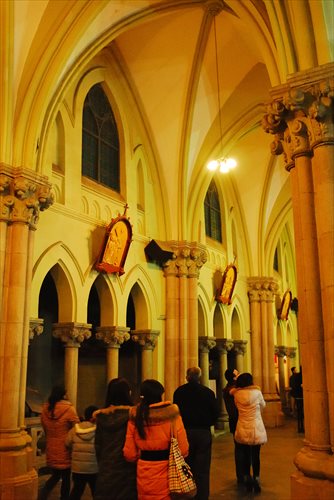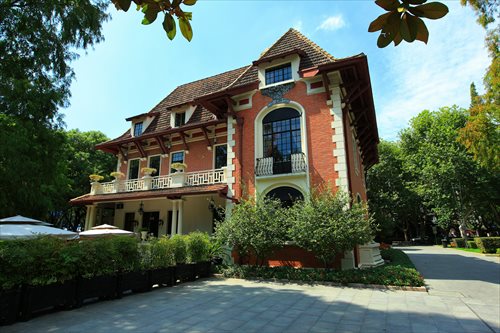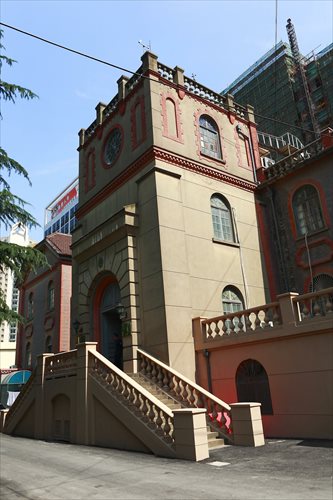Xujiahui stories
After metro Line 9 runs through Shanghai's southeast suburban area, it goes back downtown and overlaps with metro Line 1 and Line 11 at Xujiahui station. A major commercial and entertainment hub, Xujiahui boasts top international brands and bustling shopping malls, as well as points of historical interest. The central part of Xujiahui encompassing its main attractions has been dubbed Xujiahui Origin, where visitors can find all the attractions listed below.

Inside Xujiahui Cathedral
Located in southeast Shanghai, Xujiahui was once the property of Xu Guangqi (1562-1633), China's most notable Catholic convert and a pioneer in the cultural exchange between China and the Western world. As minister of rites and grand secretary in the Ming Dynasty (1368-1644), Xu wrote many works on subjects including mathematics, and cultivated farmland to experiment with new agricultural practices. The area of Xujiahui was largely inhabited by Xu's descendants, and in the late 17th century, it took the name Xujiahui, meaning "property of the Xu family at the junction of rivers."
Though the area no longer belongs to the Xu family, visitors can still trace the history back by walking through Xujiahui. Designated as "the first open metropolitan tourism area" in Shanghai, Xujiahui Origin contains a historical zone, a commercial center and an ecological green space with an area of 2.4 square kilometers.
Xujiahui Cathedral
It takes just a few minutes to walk to Xujiahui Cathedral (158 Puxi Road, 5425-9260) from metro exit 3. Known as the St. Ignatius Cathedral, it is the mother church of the Roman Catholic Diocese of Shanghai. The cathedral was designed by English architect William Doyle in 1904 and built by French Jesuits from 1906 to 1910. On every July 14, the national holiday of France, the cathedral holds a grand Mass and raises the French national flag.
With typical Gothic architecture, a pair of 57-meter-high belfries stand at the front, while two 31-meter-high spires each hold a huge cross aloft. Inside the cathedral, there are 64 skillfully carved columns, each composed of 10 small pillars. The cathedral has a capacity of 3,000 people.
The main body of the cathedral is made of brick and wood, so the cross-shaped building appears scarlet from the outside. Many young couples choose the cathedral as a location for shooting wedding pictures. It opens from 9 am to 11 am and 1 pm to 4 pm from Monday to Saturday; and 2 pm to 4 pm Sunday.
Visitors can look around the first floor of the cathedral. It is closed to the public on the first Friday of every month and during religious activities.
Former Site of Pathé
Located near Xujiahui Park, the three-story red building is nestled in foliage. In 1921, the record company Pathé Orient bought the land and built the red Dutch-style villa (811 Hengshan Road, 5425-9260). Ever since, music has flowed from the building, which is regarded as the cradle of China's recording industry. During the 1930s and 1940s, lots of patriotic songs were created and recorded in the villa. 'March of the Volunteers' (lyrics by Tian Han and music by Nie Er), which later became the national song of China, was recorded here in 1935.
Its exterior is made of brick and wood, with inlaid stone in the middle of its north side, and two pillars supporting the south balcony. The villa was listed by the Shanghai municipal government as an Excellent Historical Building in 2005. There is a restaurant on the second floor.
The building opens from 9:30 am to 10:30 am Sunday to Wednesday.

Former Site of Pathé Photos: CFP
Xujiahui Observatory
Xujiahui Observatory (166 Puxi Road,5425-9260) was the first weather observatory along China's costal area. It was originally built in July 1872 by Jesuits, and began observation some five months after.
In 1873, several annexes were built as weather stations alongside the observatory. In 1900, a new observatory was constructed to the west of the original.
The three-story building has a distinctive red brick design. It has a 40-meter-high anemometer tower for measuring wind speed.
In 1926 and 1933 it took part in international projects to accurately determine points of longitude, and became one of three major benchmark providers of date in the world. It was designated as a site for establishing standard time by the International Astronomical Union.
Visitors have to make reservations at least one day before visiting. The building is only open to the public for two half-hour periods, at 10 am and 2 pm, on weekends.

Xujiahui Observatory
Since the interior is in the process of being converted into a museum, visitors can currently only look around the exterior of the observatory.
Editor's note:
This year is the 21st anniversary of the opening of the Shanghai metro. The subway has facilitated more than 13 billion journeys during its 21 years, and half of Shanghai citizens cite the metro as their favored mode of transport. To commemorate the anniversary, each week the Global Times will take an in-depth look at one metro station and its surroundings. In the case of downtown stations, we will focus on points of interest within walking distance; while for suburban areas, we will cast our net a little wider.

map
Newspaper headline: Lifting the historical lid on the commercial hub